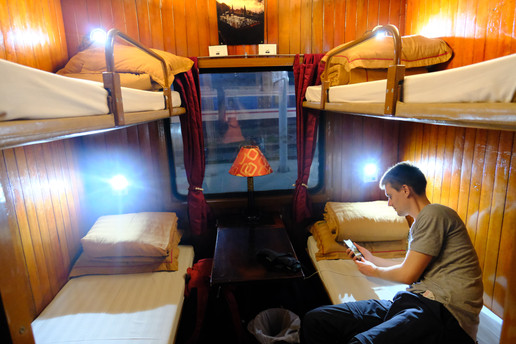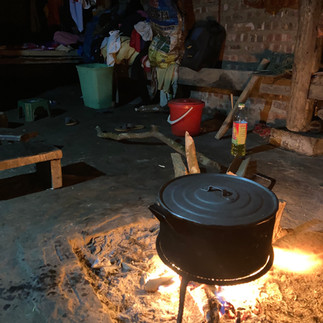Trek through the rice terraces of Sapa, Vietnam: overnight stay with locals and immersion in the Hmong community
- cam.campo

- Apr 21
- 6 min read
Updated: Aug 19
Iconic of any trip to Vietnam, the terraced rice fields of Sapa are a must-see. And what better way to discover them than by being guided by those who know them best: the locals themselves!

In this article, you’ll first discover who the Hmong are — the community living in Sapa’s rice fields — and then a detailed account of our two-day immersive trek among them, in the heart of breathtaking landscapes.
Who are the Hmong?
The Hmong are a small ethnic community living in the highlands of the Sapa region, near the Chinese border. This remote group lives somewhat on the margins of Vietnamese society; very few of them speak Vietnamese, which limits their integration. Until recently, the Vietnamese government regarded them as inferior to the Vietnamese population. Families still live in extreme poverty, working together in the rice fields and surviving off their harvests and livestock. School enrollment remains low, although it has been increasing in recent years.

We highly recommend meeting this wonderful community, learning about their traditions, and admiring the landscapes they call home. The Ethos - Spirit of the community association, which advocates for women and children's rights within the Hmong community, offers day trips or 2–3 day treks with overnight stays in local homes.
This experience was one of the most meaningful and unforgettable we’ve ever had. We chose the 2-day/1-night option, which truly allowed us to share real moments with the people of this community.
What is the trek through the rice fields like?
Before the trek, we took an overnight train from Hanoi. Make sure to book your ticket in advance and choose a reputable company, as quality varies greatly. We booked with company Sapaly Express, reserving two beds in a 4-person sleeper cabin for 31€ (one way). Train staff offered to "upgrade" us by paying extra in cash to privatize the cabin — which we accepted — but later realized the train was practically empty. Classic scam... oh well.
Our train left Hanoi around 10 PM and arrived in Lao Cai at about 7 AM the next morning.
Tip: Bring warm clothes, an eye mask, and earplugs.
Day 1:
Arrival in Lao Cai around 7 AM after a short but rough night on the train’s basic beds.
Meet-up at the Ethos agency
Thankfully, we had booked a transfer with Ethos in advance, since their office is located outside of Sapa town and would’ve been hard to reach on our own.
We were greeted by the welcome team and had a hearty breakfast — very much needed! More travelers gradually arrived. We had a group briefing and were given cultural context about the Hmong, in addition to information posted throughout the agency’s reception area.
Departure into the rice fields
We took a one-hour taxi ride with our guide, dressed in a beautiful, colorful traditional outfit. Then the trek began — in the middle of nowhere! The landscapes were breathtaking, everything I had dreamed of for years. For two days, we didn’t see a single other tourist.

Lunch with a local family
We stopped for lunch in one of the first villages we passed. A welcoming young couple hosted us in the family home they shared with their parents. Living conditions were extremely basic — no running water or electricity, and a dirt floor. We helped prepare the meal, which was absolutely delicious: meat, vegetables, and rice. Through our guide, we had the chance to exchange stories and traditions with the couple. It was eye-opening to see how different our lives were despite being the same age.
Back to the trail
We hit the trail again to make it to our destination before nightfall. The scenery was dramatically different from the morning — much greener and steeper. We passed many Hmong people working the fields. Women carried babies on their backs, men guided oxen to till the soil. At that time of year, they were creating channels to flood the rice paddies from top to bottom. Problem was, with no clear path, we got stuck facing water-filled paddies and had no choice but to walk barefoot through them. Honestly, it wasn’t the most pleasant moment — lots of little creatures floating around — but in hindsight, it’s a great memory.

An exhausting but fulfilling day
We arrived in the village where we’d be spending the night and met our host family with four kids. Despite the sweat and grime, there was no shower available. Thankfully, we’d brought wipes! We helped prepare dinner — spring rolls this time, which was a blast. The father even killed a chicken for the meal. It was a fun and meaningful moment, with our guide again acting as interpreter.
We slept in one of the family’s wooden houses on a... wooden bed.
Day 2:
Early start, with a breakfast of rice and meat to fuel the adventure.
Bamboo forest discovery
First stop: a bamboo forest. Completely unexpected and very cool. We feared snakes but saw none — though we did encounter crabs and leeches.

Lush green rice fields
We entered a new valley with even greener terraces than the day before. An absolute delight for the eyes. We saw many Hmong communities working together in traditional ways, tilling the land with their oxen.

Lunch at a local farm
Lunch was hosted by an older woman in a big house shared with her family. She raised chickens and had many small birds in cages. The view over the valley was stunning. We ate spinach-like leaves picked during our morning hike, cooked with garlic and oil — delicious!

Final kilometers
We set off again shortly after lunch, and these last kilometers felt endless! The trail ended in a much flatter valley that, once again, looked nothing like what we had seen before.
Return to Hanoi
Our taxi was waiting to take us back to the Ethos agency, where we changed clothes before the shuttle picked us up to return to the train station. Back to Lao Cai for the night train — and this time, we slept like babies!
What should you absolutely bring for a Sapa rice field trek?
We made the mistake of packing ultra-light, which seemed smart at first, but we missed key items like sunscreen. Here’s what you absolutely must pack:
Sunscreen
Cap or hat
Sunglasses
Rain jacket
Wet wipes
Water bottles or refillable canteens
Basic medications
Several pairs of socks
Bring only the essentials — you’ll be carrying everything for two days.And don’t forget: at this altitude, the sun is intense! That’s where we got our worst sunburns.
Questions about the rice terraces of Sapa? Find all our tips in the Q&A below.
What is the best season to visit the rice terraces of Sapa?
The best time to visit Sapa depends on the landscapes you want to see — each season has its own charm.
September – November:
Golden, dry rice terraces – harvest season
Mild temperatures, ideal for treks and hikes
April – Early June:
Water-filled rice terraces
Mild temperatures, perfect for trekking
June – August:
Terraces still beautiful
Rainy season – strongly discouraged
December – February:
Bare terraces, little visual interest
Cold season
Which agency offers treks through the rice terraces of Sapa?
We have chosen the agency Ethos - Spirit of the Community. It was truly a great experience. This agency promotes sustainable tourism and provides fair compensation to the Hmong community.
Which community lives in the rice terraces of Sapa?
The Hmong community is the main group living in the rice terraces of Sapa, Vietnam.
How to get to Sapa from Hanoi?
An overnight train takes you from Hanoi to Lao Cai, where you can then take a bus to reach Sapa.
It’s also possible to take an overnight bus directly from Hanoi to Sapa.
What is the cost of a trek through the rice terraces of Sapa?
The two-day trek we did cost $125 per person. The larger the group, the lower the price per person. Prices can vary greatly depending on the agency, as each excursion offers very different activities. Make sure to do your research before booking.














































Comments